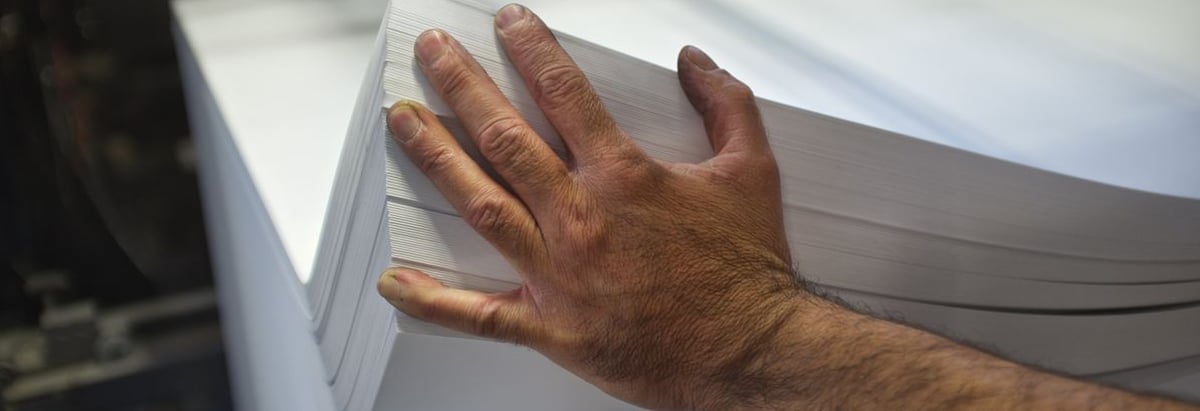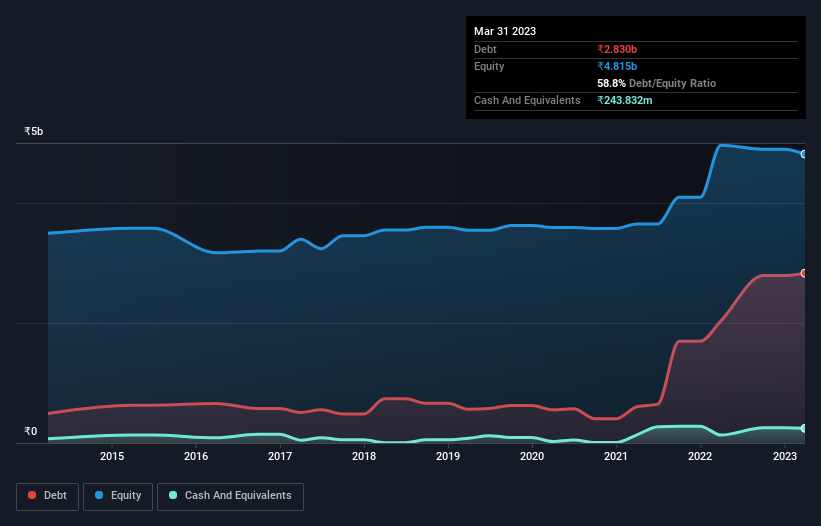- India
- /
- Paper and Forestry Products
- /
- NSEI:GENUSPAPER
Genus Paper & Boards (NSE:GENUSPAPER) Seems To Be Using A Lot Of Debt

Warren Buffett famously said, 'Volatility is far from synonymous with risk.' So it seems the smart money knows that debt - which is usually involved in bankruptcies - is a very important factor, when you assess how risky a company is. Importantly, Genus Paper & Boards Limited (NSE:GENUSPAPER) does carry debt. But should shareholders be worried about its use of debt?
When Is Debt Dangerous?
Debt and other liabilities become risky for a business when it cannot easily fulfill those obligations, either with free cash flow or by raising capital at an attractive price. Part and parcel of capitalism is the process of 'creative destruction' where failed businesses are mercilessly liquidated by their bankers. While that is not too common, we often do see indebted companies permanently diluting shareholders because lenders force them to raise capital at a distressed price. Having said that, the most common situation is where a company manages its debt reasonably well - and to its own advantage. When we think about a company's use of debt, we first look at cash and debt together.
See our latest analysis for Genus Paper & Boards
What Is Genus Paper & Boards's Net Debt?
As you can see below, at the end of March 2023, Genus Paper & Boards had ₹2.83b of debt, up from ₹2.04b a year ago. Click the image for more detail. However, it does have ₹243.8m in cash offsetting this, leading to net debt of about ₹2.59b.

A Look At Genus Paper & Boards' Liabilities
Zooming in on the latest balance sheet data, we can see that Genus Paper & Boards had liabilities of ₹2.58b due within 12 months and liabilities of ₹2.03b due beyond that. Offsetting these obligations, it had cash of ₹243.8m as well as receivables valued at ₹821.5m due within 12 months. So it has liabilities totalling ₹3.55b more than its cash and near-term receivables, combined.
This deficit is considerable relative to its market capitalization of ₹4.71b, so it does suggest shareholders should keep an eye on Genus Paper & Boards' use of debt. Should its lenders demand that it shore up the balance sheet, shareholders would likely face severe dilution.
We use two main ratios to inform us about debt levels relative to earnings. The first is net debt divided by earnings before interest, tax, depreciation, and amortization (EBITDA), while the second is how many times its earnings before interest and tax (EBIT) covers its interest expense (or its interest cover, for short). Thus we consider debt relative to earnings both with and without depreciation and amortization expenses.
Genus Paper & Boards shareholders face the double whammy of a high net debt to EBITDA ratio (7.5), and fairly weak interest coverage, since EBIT is just 0.39 times the interest expense. This means we'd consider it to have a heavy debt load. Even worse, Genus Paper & Boards saw its EBIT tank 80% over the last 12 months. If earnings keep going like that over the long term, it has a snowball's chance in hell of paying off that debt. When analysing debt levels, the balance sheet is the obvious place to start. But it is Genus Paper & Boards's earnings that will influence how the balance sheet holds up in the future. So if you're keen to discover more about its earnings, it might be worth checking out this graph of its long term earnings trend.
Finally, a company can only pay off debt with cold hard cash, not accounting profits. So the logical step is to look at the proportion of that EBIT that is matched by actual free cash flow. Over the last three years, Genus Paper & Boards saw substantial negative free cash flow, in total. While investors are no doubt expecting a reversal of that situation in due course, it clearly does mean its use of debt is more risky.
Our View
On the face of it, Genus Paper & Boards's conversion of EBIT to free cash flow left us tentative about the stock, and its EBIT growth rate was no more enticing than the one empty restaurant on the busiest night of the year. And even its net debt to EBITDA fails to inspire much confidence. After considering the datapoints discussed, we think Genus Paper & Boards has too much debt. That sort of riskiness is ok for some, but it certainly doesn't float our boat. The balance sheet is clearly the area to focus on when you are analysing debt. However, not all investment risk resides within the balance sheet - far from it. For example Genus Paper & Boards has 3 warning signs (and 2 which make us uncomfortable) we think you should know about.
At the end of the day, it's often better to focus on companies that are free from net debt. You can access our special list of such companies (all with a track record of profit growth). It's free.
New: Manage All Your Stock Portfolios in One Place
We've created the ultimate portfolio companion for stock investors, and it's free.
• Connect an unlimited number of Portfolios and see your total in one currency
• Be alerted to new Warning Signs or Risks via email or mobile
• Track the Fair Value of your stocks
Have feedback on this article? Concerned about the content? Get in touch with us directly. Alternatively, email editorial-team (at) simplywallst.com.
This article by Simply Wall St is general in nature. We provide commentary based on historical data and analyst forecasts only using an unbiased methodology and our articles are not intended to be financial advice. It does not constitute a recommendation to buy or sell any stock, and does not take account of your objectives, or your financial situation. We aim to bring you long-term focused analysis driven by fundamental data. Note that our analysis may not factor in the latest price-sensitive company announcements or qualitative material. Simply Wall St has no position in any stocks mentioned.
About NSEI:GENUSPAPER
Genus Paper & Boards
Primarily manufactures and sells kraft paper in India and internationally.
Slight with imperfect balance sheet.
Similar Companies
Market Insights
Community Narratives




